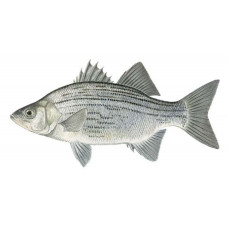Latin name
Morone chrysops
Other names
White lightning, barfish, striped bass, silver bass, striper, stripe, sandbass, and sandy; French: bar blanc.
Identification
White bass has a moderately deep and compressed body, which is elevated behind a small head and a large mouth, deepest between the two dorsal fins. It also has 11 to 13 rays on the anal fin and one to two teeth on the posterior part of the tongue. The coloration is mostly silvery, with a dark gray-green hue on the back and 4 to 10 dark horizontal stripes running along the sides. It also has yellow eyes, dorsal and caudal fins from transparent to dusky, and pectoral and pelvic fins from transparent to white. White bass is sometimes confused with other members of the temperate bass family. It is similar to striped bass (M. saxatilis), having the same silvery flanks and black stripes. However, it is shorter, has a smaller head, a deeper body, a hunched back, and dorsal fins that are closer together. White bass is also similar in appearance to yellow bass (M. mississippiensis), but has a silvery color and continuous stripes, as well as a protruding lower jaw (in yellow bass, jaws are arranged similarly). In white bass, the barbed and soft parts of the dorsal fin are separated, whereas in yellow bass they are connected at the base. White bass also thrives in some waters inhabited by white perch (M. americana), especially in the Great Lakes and their tributaries. White bass can be distinguished from white perch by the absence of distinct stripes on the sides of the white bass body, although stripes are sometimes found on juveniles of this species.
Distribution
White bass has a wide distribution, extending through the Mississippi Valley river systems (including Texas, northwest Florida, and Louisiana), the Ohio Valley, and the Great Lakes. A native of the St. Lawrence River to the east, Lake Winnipeg to the north, and the Rio Grande to the west, they are found from Canada to the Gulf of Mexico. They have been bred within and outside their natural range and transplanted to various states, including California.
Habitat
White bass are most abundant in clean, cool lakes, reservoirs, ponds, and pools of small and large rivers. It prefers lakes larger than 300 acres and with significant areas of water at least 10 feet deep.
Size
White bass average 1⁄2 pound to 2 pounds, but can reach 3 to 4 pounds. The world record in Alltackle tackle is 6 pounds, 13 ounces. They can grow up to 173⁄4 inches in length, averaging 10–12 inches, and can live at least 10 years, but few live to 4 years. Females grow faster and probably live longer than males. Regional differences in growth are due to cold water and lack of shad in the north, and warm water and abundant populations of gizzard and threadfin shad in the south.
Life history and Behavior
To spawn, white bass migrate within freshwater rivers no more than 40 miles. Two-year-old sexually mature males reach the spawning grounds about a month before the females appear and move to the same spawning grounds each year. They arrive between February and June, depending on when water temperatures rise above 45 °F.
Food and feeding habits
White bass feed on shad, silversides, crustaceans, yellow perch, sunfish, insects, crayfish and private young. Although they stay mostly at depth, they usually come to the surface to feed on schools of small shad or other minnows. This typically occurs at the beginning or end of the day or on cloudy days.
Reproduction
Several white bass males gather around a female at a depth of 6–7 feet and push her to the surface, where she releases an egg that quickly fertilizes. Settling on rocks and vegetation in shallow water, the tiny, sticky eggs hatch after 45 hours at 60 °F. Adult fish do not protect either the eggs or the young, and as a result, very few fish survive the first year. After spawning, the adults move to deeper waters where they swim in compact flocks, often close to the surface.
| Classification | |
| Phylum | Chordata |
| Class | Actinopterygii |
| Squad | Perciformes |
| Family | Moronidae |
| Genus | Morone |
| Species | M. chrysops |
| Features | |
| Conservation status | Least Concern |
| Habitat | Pelagic |
| Life span, years | 10 |
| Maximum body weight, kg | 3.1 |
| Maximum length, cm | 43 |
| Sailing speed, m/s | No information |
| Threat to people | Edible |
| Way of eating | Predator |

